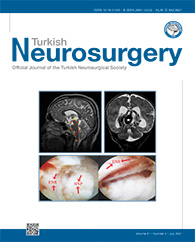2Turkish Ministry of Health, Ankara City Hospital, Department of Neurosurgery, Ankara, Turkey
3Ankara Yildirim Beyazit University Faculty of Medicine, Department of Biochemistry, Ankara, Turkey
4Ankara Yildirim Beyazit Faculty of Medicine, Department of Neurosurgery, Ankara, Turkey DOI : 10.5137/1019-5149.JTN.28235-19.5 AIM: To analyze Chromogranin A levels on vasospasm in an experimental subarachnoid heamorrhage (SAH) model.
MATERIAL and METHODS: Sixteen Wistar Albino male rats were used in study. Two groups are formed; first was consisting of 8 rats that experimental SAH was performed on them, second group was control group that nothing was done. Animals were sacrified fourtyeight hours later subarachnoid heamorrhage was occured. Peripheral venous blood samples were taken from the experimental group before SAH formation, 15 minutes, 75 minutes after experimental SAH formation and 48 hours as peak of vasospasm. Simultaneous peripheral venous blood samples were also collected from the control group. Blood samples were biochemically evaluated after centrifugation and serum Chromogranin A levels were studied.
RESULTS: Serum chromogranin A levels increased statistically significant (p<0.05) at the 15th minute after SAH, as the samples obtained from the experimental and control groups were anticipated as a result of the statistical analysis of the data after the biochemical examinations.
CONCLUSION: In all these findings, we concluded that Chromogranin A could be used as a marker for the investigation of endocrine stress in the early period of post-SAH vasospasm and it could be proved by more studies.
Keywords : Subarachnoid haemorrhage, Vasospasm, Chromogranin A, Endocrin stress, Rat




